Vol 4 No. 32 TROPIC LIGHTNING NEWS August 11, 1969
Index
Operation Nutcracker
Is Sweet for Fire Brigade
CU CHI - In ten hours of fierce
fighting ten miles northwest of here, a joint effort by 2d Brigade units scored
a heavy blow against enemy forces.
Aided by air strikes and gunships, Bravo Company, 1st Battalion
(Mechanized), 5th Infantry; Alpha and Charlie Companies of the 2d Battalion,
12th Infantry; and elements of the 2d Battalion, 14th Infantry, combined
firepower to put the squeeze on an estimated two battalions of North Vietnamese
soldiers during “Operation Nutcracker,” in which 40 enemy were killed.
The action started when the Warrior companies began to push from
open rice paddies into an area of hedgerows and abandoned hootches. The
1/5 Bobcats were right with them.
According to Captain William Correia of Warren, R. I., “As soon
as we moved into the area, several enemy began running from the hedgerow.
We fired over their heads and they retreated into the thick brush.”
The target was “softened” with artillery fire, and then the
ground units moved in. Alpha Company platoon leader 2d Lieutenant Tony
Harper of Jacksonville, Fla., stated, “We had just entered the wooded area
when we noticed fresh sandal prints around some spider holes and tunnels.
We held up and started to check things out when the enemy opened up from a
bunker.”
The mechanized company had not gone far, either, before the first
enemy soldier popped out of a hole with his AK-47 blazing.
Specialist 4 Flaco Conklin of New Haven, Conn., said, “I was
manning the .50 caliber machine gun on my track when an enemy soldier popped up
out of his hole only three feet in front of us and started shooting his AK on
automatic at us. One shot creased my helmet. Luckily his weapon
jammed, which saved my life.”
Shortly thereafter the track driver, Alvarado Baltazar, Jr.,
dropped a grenade in the hole, killing the occupant. Baltazar is from San
Antonio, Tex.
The mechanized company could move only 50 meters farther before
several automatic rifles opened up on it. Bobcat .50 caliber machine guns
quickly silenced the positions and drove the occupants from their
well-camouflaged holes.
Charlie Company of the 2d Battalion, 12th Infantry received enemy
fire almost simultaneously and under similar circumstances. Under the
covering of fire from gunships, the Tropic Lightning troopers were pulled back
to allow artillery and air strikes to pound the enemy lair.
Specialist 4 Juergen Marshall remarked, “The air strikes and
gunships really did a good job on that place. The first gunship slammed
some rockets into the bunker that was giving us the most trouble.”
Devastating artillery and air strikes continued while 2d Brigade
units organized their re-entry into the enemy bunker complex. Sporadic
fire met the 25th Division troops.
“We had to fight our way through that entire hedgerow,” said
Conklin. “NVA were coming up out of holes all over the place.”
“The holes were so well-concealed and the enemy so patient.”
said Correia, “that we sometimes didn’t make contact until after we had
passed their positions.”
When the Warriors moved back into the trouble spot, they made use
of grenades and LAWs against the enemy snipers.
Private First Class Gene Loving of Chester, S.C., said, “We were
really working out with LAWs. We made a lot of direct hits on bunkers.”
By the time darkness fell, 40 dead NVA had been discovered.
Captured enemy weapons included 18 AK-47 assault rifles, three RPG-2 launchers,
one K-54 pistol, and one .51 caliber machinegun with tripod. Twenty 107mm
rockets were also discovered and destroyed. More than a pound of enemy
documents was confiscated during the engagement.
After a hard day of fighting, the mechanized unit set up a night
defensive position near the contact area. Early the following day, they
made another sweep, finding more documents and assorted munitions. Three
enemy suspects were detained.
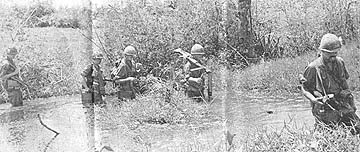 |
FOOT SAILING - The Golden Dragons display “navigation” tactics as they maneuver across a stream in the marshes near Cu Chi. (PHOTO BY PFC FRANKIE DITTO) |
Wolfhounds Move Fast,
Aid CIDG
CU CHI - Wolfhound infantrymen from
the 2d Battalion, 27th Infantry, came to the aid of a Vietnamese irregular
defense group which had become surrounded by North Vietnamese troops 22 miles
southwest of Cu Chi near the Kinh Bo Bo Canal. The Tropic Lightning
soldiers routed the enemy force, killing 47.
An additional 20 enemy were killed by gunships of Bravo Company,
25th Aviation Battalion. Fourteen more were killed by the Civilian
Irregular Defense Group (CIDG).
The CIDG soldiers had been operating
in an area known as the Parrot’s Beak when they encountered an unknown number
of North Vietnamese soldiers. The irregulars, from the Due Hue area, took
heavy casualties early in the battle. Evacuation of dead and wounded was
hampered by heavy volumes of fire from fortified enemy positions.
Delta Company, 2d Battalion, 27th Infantry, came into the area on
an eagle flight in midafternoon to reinforce the irregulars. Two platoons
of Delta Company came under heavy fire while sweeping the eastern side of the
Kinh Gay Canal.
“Our 2d and 3d platoons were sweeping up the canal toward the
area of contact when our lead element got pinned down by snipers,” said
Sergeant Steve Langston of Logansport, Ind., a Delta Company platoon sergeant.
“There were about ten positions very close to the canal.
They kept popping up and down, keeping us from moving up to evacuate casualties,”
stated Langston.
Lieutenant Colonel Forest Rittgers,
Jr., of Manlius, N.Y., Battalion Commander, took personal charge of the Delta
troopers when the company commander was hit by enemy fire.
Meanwhile, Charlie Company of the Wolfhounds had been called to
assist Delta when it was pinned down by heavy sniper fire. Charlie Company
flanked the dug-in enemy positions and fought hard to get the trapped Vietnamese
and American soldiers out.
“The NVA would not budge and were
well-concealed,” said Private First Class George Diaz of New York City.
“We could not see them so we just kept up our volume of fire to the front of
us. Finally we drove them out.”
Wolfhound soldiers from the 1st Battalion, 27th Infantry, swept
through the area the next day capturing weapons and supplies and confirming the
enemy body count.
Included in their finds were two light machineguns, one AK-47
rifle, 18 Chicom hand grenades, seven 60mm mortar rounds, 123 blasting caps, 32
sets of clothing, medical supplies, a pound of enemy documents and various other
NVA field equipment.
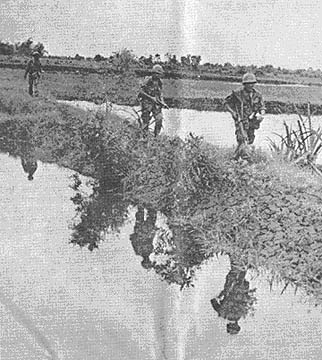 |
ABOVE AND BELOW - No matter how you look at it, the Wolfhounds are on top. (PHOTO BY PFC PHIL JACKSON) |
| Too many Americans in Vietnam are becoming Traffic Casualties. Rules of the Road are made for your protection. It’s folly not to obey them. DEROS. Do it the safe way. |
Page 2 TROPIC LIGHTNING NEWS August 11, 1969
Decorated
| DISTINGUISHED FLYING CROSS | |
|
CPT Paul F. Allen, HHC, 2d Bn, 12th Inf 1LT Terry E. Cory, HHS Btry, Div Arty 1LT Kendall E. Hatton, 1st Bn, 8th Arty WO1 Tom H. James, Co A, 25th Avn Bn |
WO1 John A. Driscoll, Jr., Co A, 25th Avn Bn SGT Michael P. Swim, HHC, 25th Avn Bn SP4 Louis H. Anderson, Co A, 25th Avn Bn PFC Phillip Langston, Co A, 25th Avn Bn |
| SILVER STAR MEDAL |
|
|
LTC Tommie G. Smith, HHC, 2d Bn, 34th Armor |
SGT Robert J. Gast, Co A, 1st Bn, 5th Inf |
| BRONZE STAR MEDAL (HEROISM) |
|
|
LTC Constantine J. Blastos, HHC, 2d Bn, 14th Inf MAJ Roy C. Campbell, HHC, 1st Bde, CPT Arthur L. Minnefield, Co C, 4th Bn, 23d Inf CPT Gary Peters, HHB, 1st Bn, 8th Arty CPT Peter D. Wells, B Trp, 3d Sqdn, 4th Cav CPT Bud R. Brown, Co A. 1st Bn, 5th Inf 1LT Robert R. Castona, Co D, 2d Bn, 27th Inf 1LT Joseph L. Krawczyk, B Trp, 3d Sqdn, 4th Cav 1LT Patrick L. Smith, Co E, 1st Bn, 27th Inf 1LT Anthony R. Faiia, Co A, 2d Bn, 34th Armor MSG Darrell E. Olson, HHC, 2d Bn, 14th Inf PSG Douglas Mehio, Co B, 4th Bn, 9th Inf PSG Mitchell V. Rader, C Trp, 3d Sgdn, 4th Cav SFC Coy C. Crosby, B Btry, 1st Bn, 8th Arty SFC Dale L. Parsons, Co B, 65th Engr Bn. SSG Navarro G. Acosta, B Btry, 1st Bn, 8th Arty SSG Robert L. Norton, Co B, 4th Bn, 9th Inf SSG Vincent Killelea, Co C, 4th Bn, 23d Inf SSG Jimmie Marks, B Btry, 1st Bn, 8th Arty SSG Henry B. Miraldi, B Btry, 1st Bn, 8th Arty SSG Leonard Simpson, Co B, 4th Bn, 9th Inf SSG Jack A. Thomas, Co B, 4th Bn, 9th Inf SSG George J. Bleichert, C Trp, 3d Sgdn, 4th Cav SSG Raymond Young, Co A, 2d Bn, 14th Inf SSG Leslie R. Koch, A Btry, 7th Bn, 11th Arty SSG Frank E. Williams, C Trp, 3d Sgdn, 4th Cav SSG Welton C. Newsome, HHS Btry, 7th Bn, 11th Arty SSG Joseph B. Newbury. C Trp. 3d Sgdn, 4th Cav SSG Lloyd W. Heller, Co E, 1st Bn, 27th Inf SGT Billy D. Browning, B Btry, 1st Bn, 8th Arty SGT Denn C. Marinovich, B Btry, 1st Bn, 8th Arty SGT Delton O. White, Co C, 4th Bn, 23d Inf SGT Charles Garrison, B Btry, 1st Bn, 8th Arty SGT Carroll Springer, Co B, 65th Engr Bn SGT Clarence H. Flynt, Jr., B Btry, 1st Bn, 8th Arty SGT Daniel Contreras, Co C, 4th Bn, 9th Inf |
SGT John W. Mishu, J., HHC, 3d Bn, 22d Inf SGT Ray E. Davis, Co A, 4th Bn, 23d Inf SGT Donald George, Co B, 4th Bn, 9th Inf SGT James H. Iman, Co A, 65th Engr Bn SGT John L. Riche, C Trp, 3d Sqdn, 4th Cav SGT Dennis Kontz, Co A, 3d Bn, 22d Inf SGT Glenn E. Bills, Co E, 65th Engr Bn SGT Randall A. Brummett, A Btry, 7th Bn, 11th Arty SGT Richard E. Caven, Co C, 1st Bn, 5th Inf SGT Leonard Amberger, Co C, 4th Bn, 23d Inf SGT Danny L. Austreng, Co B, 4th Bn, 23d Inf SGT Harley C. York, Co A, 2d Bn, 34th Armor SGT Victor B, Arcuri, Co C, 4th Bn, 23d Inf SGT Clifford W. Lampi, Co A, 1st Bn, 5th Inf SP5 Edmund T. Mooney, B Trp, 3d Sqdn, 4th Cav SP5 Charles G. Jacobson, Co E, 65th Engr Bn SP5 Anthony R. Haggard, Co E, 65th Engr Bn SP5 Theodore Medina, Co E, 2d Bn, 12th Inf SP5 Joseph J. Tamblyn, B Trp, 3d Sqdn, 4th Cav SP5 David Fulks, Co D, 2d Bn, 34th Armor CPL Charles Kiniyalocts, Co C, 1st Bn, 5th Inf CPL William F. Horn, B Btry, 1st Bn, 8th Arty CPL Bruce Nothstein, B Btry, 1st Bn, 8th Arty CPL Dennis E. Dahlinger, B Btry, 1st Bn, 8th Arty CPL Herbert E. Brooks, B Btry, 1st Bn, 8th Arty SP4 Calvin M. Wyant, Co C, 2d Bn, 14th Inf SP4 Robert F. Nadeau, Co C, 4th Bn, 23d Inf SP4 David L. Tarver, Co E, 65th Engr Bn SP4 Anthony Zamora, Co C, 4th Bn, 23d Inf SP4 Danny F. Sparks, Co B, 2d Bn, 22d Inf SP4 Curtis Ward, A Btry, 7th Bn, 11th Arty SP4 James D. Powers, B Trp, 3d Sgdn, 4th Cav SP4 Charles R. Bowman, HHC, 4th Bn, 9th Inf SP4 James V. Hetherington, Co B, 4th Bn, 9th Inf SP4 Dene W. Morris, Co C, 4th Bn, 9th Inf |
Military Justice Act Spawns
New Court-Martial Manual
On August 1, 1969, the Army began working with a manual for
courts-martial that will not be available for complete distribution until autumn
of this year.
The Manual for Courts-Martial, United States, 1969 (Revised
Edition) was necessitated by the passage of the Military Justice Act of 1968.
The Manual supersedes the current 1969 unrevised edition and
incorporates significant changes in military justice procedures. Since
these changes became effective August 1, and because the manual will not be
distributed until September 1, commanders or anyone with questions relating to
the changes are urged to refer to the Staff Judge Advocates office.
The major changes in the revised manual follow:
1. An accused may not be tried by summary court without his consent
even if he has refused punishment under the provisions of Article 15.
2. An accused before a special court-martial must be afforded an
opportunity to be represented by legally qualified counsel unless such counsel
cannot be obtained due to physical conditions or military exigencies.
(Captain Stephen Holm of the SJA office indicated that simply being
in Vietnam is not a physical condition that would preclude one’s being granted
legally qualified counsel.)
3. The powers of military judges have been increased and a military
judge may be appointed to a special court-martial. The powers of the
president of a special court-martial without a military judge have also been
increased.
4. A bad-conduct discharge may be adjudged by a special
court-martial if a verbatim record of the trial is made, a legally qualified
defense counsel is detailed, and a military judge is detailed unless a military
judge cannot be obtained because of physical conditions or military exigencies.
5. An accused has a right to request trial by the military judge
alone in any case to which a military judge has been detailed, provided the
death penalty may not be adjudged.
6. An accused who has been sentenced to confinement may request
that the service of the sentence to confinement be deferred until the sentence
is ordered executed.
7. An accused at any time up to two years from the date of his
conviction by a court-martial may petition for a new trial based on newly
discovered evidence.
8. An accused may petition the Judge Advocate General of the Army
for extraordinary relief, to include the setting aside of any or all of the
findings of guilty and any or all of the sentence adjudged by the courtmartial
in any case where he feels that there has been a fraud on the court, newly
discovered evidence, lack of jurisdiction or error prejudicial to his
substantial rights.
That’s a Good Idea
The Army wants your ideas and is willing to pay cash awards up to
$25,000 for any of your brainstorms which are adopted.
Submitting an idea is simple. Your idea may be submitted by
letter, on a plain piece of paper, or on suggestion form DA Form 1045. The
only thing you need is a good idea and initiative.
Your suggestion should include the following information:
a. What is the present practice, system or item being used?
b. What change or improvement do you suggest?
c. Where and how can your idea be used?
d. What savings or benefits will result?
Send your suggestion to the G-1 section, 25th Infantry Division,
and it will be fed into the great Army paper machine. Furthermore, you
will receive a receipt (suitable for framing).
If your idea is adopted by the great idea adopter you may receive a
cash award for your thought.
Submit your idea now.
TROPIC LIGHTNING
Combat Honor Roll
Sergeant Fred Ogas, Jr., is added to the Combat Honor Roll this
week for distinguishing himself while serving with C Troop, 3d Squadron, 4th
Cavalry.
Then specialist four, Ogas was on a reconnaissance-in-force mission
when C Troop came under fire from a large, well-entrenched enemy force.
The initial exchange of fire was directed at the command element,
killing the troop commander and wounding several men.
Sergeant Ogas, riding on the command vehicle, was thrown to the
ground and seriously wounded. Disregarding his painful wounds,
he immediately moved to aid his injured comrades.
As he was evacuating two of his fellow soldiers, two insurgents
placed heavy fire on Ogas’ positions. Ogas then stormed the enemy
position and single-handedly killed the occupants of the enemy bunker with his
M-16 and grenades.
After administering aid to his wounded comrades, he realized the
troop was without effective command and immediately assumed control of the unit
and reorganized the scattered elements.
Placing his men on line and collecting the wounded, Ogas informed
the squadron commander of the situation and then guided medical evacuation
helicopters into the contact area.
At the order of the squadron commander, Sergeant Ogas chose a night
defensive position and set the troop into place and with the use of voice
communication and flares, guided another troop to his location. He kept
control of the unit throughout the battle.
Sergeant Ogas’ bravery, initiative, and aggressiveness
contributed to the defeat of a well-entrenched hostile force.
The TROPIC LIGHTNING NEWS is an authorized publication of the 25th Infantry Division. It is published weekly for all division units in the Republic of Vietnam by the Information Office, 25th Infantry Division, APO San Francisco 96225. Army News Features, Army Photo Features, Armed Forces Press Service and Armed Forces News Bureau material are used. Views and opinions expressed are not necessarily those of the Department of the Army. Printed in Tokyo, Japan, by Pacific Stars and Stripes.
MG Ellis W. Williamson . . . . Commanding General
MAJ John C. Fairbank . . . . . Information Officer
1LT John C. Burns . . . . . . . . Officer-in-Charge
SP5 Charles Withrow . . . . . . Editor
SP4 David DeMauro . . . . . . . Asst. Editor
SP4 Ralph Novak . . . . . . . . . Production Supervisor
BATTALION CORRESPONDENTS
SGT Jan Anderson
SP4 Dennis Dibb
SGT Roger Welt
PFC John Frame
PFC Sam Dixon
SP4 K. C. Cullen
SP4 Arthur Brown
PFC Larry Goodson1/5
1/5
4/23
4/23
4/23
3/22
2/12
2/12SP4 Pete Freeman
PFC Richard Sears
SP4 Carl Detrick
PFC Frankie Ditto
PFC Victor Allison
PFC Phil Jackson
PFC Craig Sampson
SP4 Pat Morrison7/11
4/9
2/34
2/14
3/4
2/27
2/27
3/13
Page 3 TROPIC LIGHTNING NEWS August 11, 1969
2/34 Provides Tanks; Infantry Provides Thanks
TAY NINH - Looking like an old-time cavalry charge, tanks from the
2d Battalion, 34th Armor, came screaming across the open fields. Making a
hard turn, the armored vehicles pulled on line without losing speed.
Suddenly, the tanks pulled to a halt. Loaders jumped into the
turrets and readied the high explosive and heat rounds. Tank commanders
ranged in the targets with experienced hands. The computer analyzed the
target at 1,900 meters.
A shattering crescendo of sound and billowing smoke pointed toward
the enemy positions. Ninety millimeter breeches flew open and as quickly
as the expended round flew out, the loader slammed home a new one. New
targets were zeroed in and fired on. Bursting rounds smothered the
entrenched positions.
ARMOR, A HIGHLY effective combat arm, has slammed enemy positions
since World War I. Here in Vietnam, tanks are again showing their
effectiveness as the backbone of field operations. The M-48A3 tank is the
standard vehicle of Tropic Lightning’s 2d Battalion, 34th Armor. Not
only does it have a 90mm cannon, but also a .50 caliber and 7.62mm machineguns.
Many of the 2/34th Dreadnaught tank crews have added an extra machine gun for
additional fire power.
Tankers, men who ride and fight in the “iron monsters,” rely on
their ability to maintain the vehicles and use them with speed and accuracy.
Although the tank crews do not hump the rice paddies on a sweep, they do endure
a number of hardships alien to the infantry.
Tankers must care for their personal weapons, machineguns, cannon
and 52 tons of steel machinery.
Their duties include replacement of 300-pound road wheels, heavy
track blocks, and “humping” 60-pound cannon rounds in resupply. After a fire
fight or just a sweep, all of these requirements must be met before even
thinking of relaxation. And often, in a heat-baked turret this means hours
of work, heavier than most found in other jobs.
DURING THE DRY season, the rumbling tanks carry clouds of dust with
them that blanket the crews from dawn to dusk. Monsoons mean mud.
Track repairs mean that first the tracks and wheels have to be dug out of the
mud. Often the mud makes the replacement parts twice as heavy as normal.
Even in the monsoon, the tanks are at least 20 degrees hotter on the inside than
outside. The flailing tracks somehow beat a rhythmic shower of dust to
cover the crew out of what should be moist ground. Yet the tank crews keep
their vehicles in constant readiness.
In recent engagements in and around the 1st Brigade area of
operations, Dreadnaught armor has been called to aid many mechanized and
“straight leg” units. The tankers poured everything they had into the
enemy positions. The results - enemy resistance was broken point-by-point,
till there was no resistance.
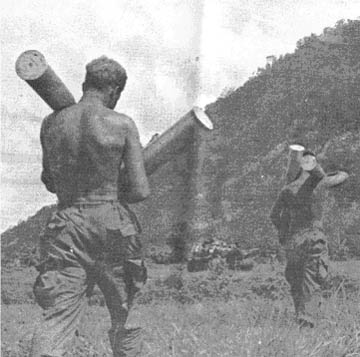 |
HUMPING THE 90’S - Alpha Company Dreadnaughts hastily move resupply rounds across rice paddies toward Nui Ba Den. (PHOTO BY SP4 CARL DETRICK) |
| SUPPORTING FIRE POWER – A Dreadnought gives .50 caliber cover fire during a joint infantry-armor operation at the base of Nui Ba Den. (PHOTO BY SP4 CARL DETRICK) | 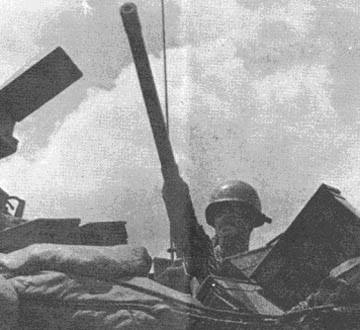 |
Cu Chi Tower Stops Snake Sneak Attack
CU CHI - In recent action on the perimeter of the Cu Chi base camp,
a snake sneak attack on a 110-foot observation tower was successfully repelled
by the tower guard and a dozen military policemen.
Private First Class Allan V. Benfant of Detroit, a tower guard for
the 1st Battalion, 8th Field Artillery, was on the afternoon shift when the
assault began. A photographer, who had been taking pictures from the
observation deck of the tall structure, had started the long climb down.
HE HAD ONLY gotten about ten feet down when startled by the sight
of a black snake entwined in the ribs of the ladder’s protective cage a few
feet beneath him. Naturally he started back up the ladder, only to be met
by another snake either jumping or falling toward him.
Luckily it only brushed him as it fell all the way to the ground.
Wasting no time, the photographer scrambled back up to the top deck where he
waited out the siege.
Tower guard Benfant then armed himself with a broom and
counterattacked. He did not see the snake until he was almost beside it
and it darted out at him, thus influencing him to retreat a few rungs up the
ladder.
ONCE IN A BETTER fighting position, the determined tower guard
continued jabbing at the snake until he dislodged it and sent it tumbling to the
second landing. Benfant pursued the sneaky intruder and unsuccessfully tried to
force it off the landing.
In the meantime, MPs had arrived on the scene and one had climbed
up the framework and was on the outside of the landing trying to oust the snake
from its perch with a rake. After breaking part of the rake, he succeeded
in knocking the reptile to the ground where the other MPs disposed of it.
When it was all over no one could explain what the snakes were
doing 85 feet up in an all-metal tower. Benfant suggested that they might
have been fleeing from the fires where workers were burning off weeds along the
perimeter bunker line. He also stated that he planned on being
particularly cautious when climbing the tower henceforth.
Survey Team Is Part of Arty Pre-planning
TAY NINH - Two Army vehicles carrying 12 men and loaded with
equipment, moved down a winding road through the Vietnamese countryside of Tay
Ninh Province. Their destination: The base of Nui Ba Den Mountain.
Their mission: Survey a specified area.
It was just another day’s work for the survey team of
Headquarters Battery, 7th Battalion, 11th Field Artillery. Traveling through Tay Ninh
Province was nothing new to them, since they have surveyed all over Tay Ninh,
from the top of Nui Ba Den to within a mile of the Cambodian border.
Lately, they have been going to the field practically every day, surveying new
field locations for the ever-increasing number of artillery batteries firing in
support of ground elements in Tropic Lightning’s 1st Brigade.
On this mission, the 7/11 crew was accompanied by members of the
25th Division Artillery survey team from Cu Chi.
Working together, the surveyors completed their field work very
quickly, finishing up at a new fire support base about a mile up the road.
Later, they would have to compute all the surveying data they had gathered in
the field, putting to use their knowledge of geometry and trigonometry.
Another day had come to a close and another successful survey
operation had been completed. Although the surveyors receive little
recognition, their work plays a vital role in achieving maximum effective
support from the artillery. But this day had all but been forgotten and
the surveyors’ thoughts were already being directed toward tomorrow, wondering
where their next job would take them.
| SURVEYING DUO - Artillery surveyors, Specialist 4 Jack Ingram of Memphis, Tenn., and Specialist 5 Ralph Ruble of Ironton, Mo., of the 7/11 survey team head up the road to set up their equipment. (PHOTO BY SP4 PETE FREEMAN) |  |
Page 4-5 TROPIC LIGHTNING NEWS August 11, 1969
A Tomahawk Civic Action Program
A Splendid Time Had By All
TAY NINH - Growing in leaps and bounds, the civic action program of
the 4th Battalion (Mechanized), 23d Infantry, is taking a firm hold on the
hamlets in the Tomahawk area of operations.
The Tropic Lightning soldiers initially started by helping to
improve the living conditions of one village, Ap Ninh Hung, near Tay Ninh City.
Now the spirited program is reaching out into several rural hamlets.
The Tomahawks have been making each program a social event.
Recently the mechanized infantrymen loaded three jeeps and one truck with
medical supplies, food stuffs, T-shirts, baseball caps, plastic kitchen ware,
and other small items that make life a little easier and headed for the small
hamlet of Soui Da. There, all the items were passed out, many of them in
the forms of prizes. A favorite item the children love is a blastic bag
that contains pencils, pens, paper and a small ruler.
While Major Al Prieto, the battalion surgeon, performed a medical
civic action program on one side of the market place, Captain Gren Fleming of
Hampton, Va., S-5 officer, and his men were busily setting up carnival-type
amusement booths.
“The villagers could hardly wait for us to get set-up,” said
Fleming. “They were so excited. I think we added a little
happiness to their lives.”
Villagers of all ages enjoyed the festivities. From throwing
darts at balloons to just watching, everybody got a taste of the best medicine:
laughter.
The day’s highlight was the foot race. Everybody was there
to cheer on his favorite runner. One small boy finally prevailed over
everybody else. He now has the distinction of being the fastest foot in
town.
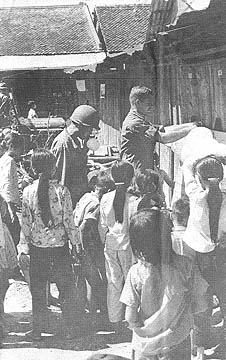 |
STEP RIGHT UP, THREE FOR A QUARTER - Well, actually it was five for a smile as a Tomahawk ties a balloon to a board in preparation for the day’s festivities. |
| ONE YOUNG CONTESTANT in the dart-throwing contest takes careful aim on his target. Winners (along with everyone else) received prizes during the Tomahawk civic action project. The balloons really don’t stand a chance against the youngsters’ dart barrage. |  |
Page 6 TROPIC LIGHTNING NEWS August 11, 1969
DIVARTY Survey Gives Precise Shell-Rep
CU CHI - Theodolite, DME, heliotrope, all strange words to laymen,
but to the 25th Infantry Division Artillery survey section they are vital
instruments needed in important and often dangerous work.
The survey section provides exact coordinates and azimuths from
surveyed points to a fire support base so artillery can fire accurately on a
target in the shortest time possible.
WHEN THE ORDER to “dig in” is given, the survey team is ready
at a fire support base. Team members know their job is important, and working
together, they determine the exact information necessary for artillery to carry
out successful fire missions.
According to the DIVARTY survey officer, Captain Robert Haney from
Wichita Falls, Tex., “Accuracy is our most important product. We are
oriented to give artillery, through accurate surveyed coordinates, a first round
hit.”
The survey section consists of two departments, Survey and the
Survey Information Center. Survey determines the actual coordinates,
angles and other information requested. SIC, according to Computer Specialist 5
James Lawrence from Othello, Wash., “Takes all field work and transfers it
into usable data for lower echelon units.”
IT IS NO EASY job and takes a lot of men to find the correct data.
Party chiefs, computers, recorders, instrument operators, tapemen - each one has
a complex job to perform. Every man, according to Haney, is cross-trained.
Each one knows at least three other jobs in the survey section besides his own.
Danger is sometimes present. Occasionally sniper fire brings
the work to a temporary halt. When the enemy is silenced, the work
continues. A Shell-rep is one of the most dangerous missions of the
DIVARTY survey section.
It is survey’s responsibility, while enemy rockets or mortars are
coming in, to go to the place of impact and analyze the crater. Information, such
as back azimuths, angle of fall and type of round are quickly determined and
sent to the 1st Battalion, 8th Artillery, Fire Direction Center where a fire
mission is initiated.
“CHARLIE FIRES three or four rounds, crawls back in his hole,
waits, then comes out and shoots again,” states Lawrence. “He’s hard
to see from the air. Artillery will have a pre-fire plan, a set location
to fire on when rockets come in. Through a shell-rep, survey will give
better locations to fire on.”
The amount of security varies. Sometimes infantry units will
accompany the survey team. Most of the time, the men are brought to their
locations by armored personnel carriers.
Their jobs are important and often dangerous. The men of the
DIVARTY survey section know teamwork is their most important tool in obtaining
the information and accuracy that is so vital.
| DISTANCE MEASURING EQUIPMENT - One way to get exact coordinates of Fire Support Base Patton II is by using Distance Measuring Equipment. Specialist 5 Jim H. Arends of Woodland Hills, Calif., checks out a DME. (PHOTO BY SP4 KEN FAIRMAN) |  |
2/12 Thwarts Bubonic Threat
CU CHI - The 2d Battalion, 12th Infantry, recently helped a small
Vietnamese hamlet eliminate one of the biggest problems that can face a people;
bubonic plague, often called Black Death.
Acting on information received by the civic affairs section, the
battalion surgeon, Captain Thomas Brugger of Portland. Ore., found confirmed
cases of the plague in the village.
A three-man medical team was airlifted into the remote hamlet where
the cases had been discovered, 12 miles west of Cu Chi. After arriving at
their destination, the 2d Brigade medics co-ordinated their efforts with an ARVN
medical officer, who also served as interpreter for the team.
“WE MADE spot checks first,” related
Brugger. “It was
raining, so we asked the village chief if we could set up in his hootch, and he
said he would permit it. We gave initial treatment to two definite plague
victims. There were other villagers who had symptoms of the plague and we treated them just to be sure.”
Altogether, the unit treated 83 people. “Not only did we
check each for plague,” said Staff Sergeant Lonnie Ashley of Carrollton, Ga.,
“but we treated everyone who had something wrong with them.”
The team may return to the village, should more cases of the
dreaded disease break out.
The Vietnamese medics took over the treatment of the victims and
gave plague-preventive shots to the villagers. A second team was scheduled
to eliminate the rodents that harbor the disease. DDT was used to wipe out
the dangerous fleas.
Major is a Clerk
CU CHI - The 2d Brigade at Cu Chi base camp has a major working as
a company clerk. Major Arnett of Seaford, Del., is a member of the 2d
Battalion, 34th Armor. The major is a Specialist 4.
Arnett, whose first name is “Major,” became a fighting company
clerk, when he joined Alpha Company in the field to get some required
information.
ARNETT HAD gathered all the data he needed when the company was
diverted to aid an element of the 1st Battalion (Mechanized), 5th Infantry which
had made contact with the enemy. Although he had never been on a sweep, he
volunteered to go with the Dreadnaught unit.
One tank was short a man, and Major suddenly became a tank gunner.
Riding the back deck of the tank, Arnett arrived during an artillery and air
strike. The tank pulled on line and waited.
As the last salvos struck the enemy positions, the Dreadnaught
armor and Bobcat mechanized infantry forces moved into the contact zone.
Reconning by fire, Arnett acted as rifleman and grenadier from the
back deck of the tank. During periods when the tank’s loader was busy
inside the tank, Arnett manned the M-60 machine gun on top of the vehicle.
FOR FOUR HOURS, the company clerk alternated in his use of weapons.
Said Arnett: “I never really thought anything about the fighting until three
Viet Cong fired a rocket-propelled grenade (RPG) in our vicinity. There
was too much noise going on to hear the RPG. But then, I’d never heard
one before, so I wouldn’t have known what to listen for anyway.”
Shortly afterward, a tank commander and loader were slightly
wounded on another tank. After the pair was dusted off, Arnett climbed
into the tank commander’s position.
Not knowing how to load and fire the main gun or machine guns,
Arnett grabbed his trusty M-16 and began to fire at the enemy positions.
Finally, after the battle was over, Arnett flew back to Cu Chi in a
helicopter, went back to his desk, and his old job as clerk.
Major Arnett had proved his combat effectiveness.
Page 7 TROPIC LIGHTNING NEWS August 11, 1969
 |
| NUI BA DEN looks down on Charlie Battery’s position as the Clansmen prepare for a night of firing. |
Clansmen Go to Tay Ninh
to Put a Thorn In Side of Nui Ba
Den
TAY NINH – Cannoneers of Battery C, 3d Battalion, 13th Artillery
(The Clan), moved from Fire Support Base Mead near Cu Chi to Tay Ninh Base Camp
to provide reinforcement against increased enemy activity here.
The move to Tay Ninh followed a buildup of NVA troops in the Tay
Ninh Nui Ba Den area. Battery C’s mission was to provide general
artillery support and reinforcement of maneuver units in the area.
Only four hours after arriving, Battery C received its first fire
mission. The firing went on all night with five of the battery’s 155mm
howitzers tallying 689 rounds fired during 27 missions in the first 24 hours.
Ten days after the move the battery moved out of Tay Ninh Base Camp
to a position within a mile of Nui Ba Den in support of the 2d Battalion, 34th
Armor, operations and maneuver units operating in the vicinity of the majestic
mountain.
 |
DEVOURED BY A MAN-EATING RPG SCREEN - Specialist 4 Carl F. Screider of Madison, Conn., looks as though he is persuaded that an RPG screen might be just as dangerous as an RPG. Specialist Schneider isn’t trying to free himself from the monster’s clutch; he just wants to get the thing up. |
| THREE CLANSMEN proceed with the unglamorous task of uncrating projos. |  |
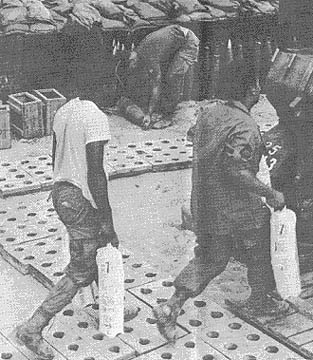 |
POWDER HANDLERS Private Roderick Woods of Bolivar, Tenn. (left), and Private First Class Jose F. Manzaanares of Pharr, Tex., take powder charges to be loaded behind the projectile in the gun tube. |
| COMING IN calls Corporal David S. Ramsey of Dearborn Heights, Mich., as he sets down the 100-pound projectile inside the howitzer for loaders to ram into the gun’s tube. In the background an ammunition handler fuses more projectiles for the mission. |  |
Page 8 TROPIC LIGHTNING NEWS August 11, 1969
24 Enemy Fall
2/12 Whips NVA in 4-Hour Fight
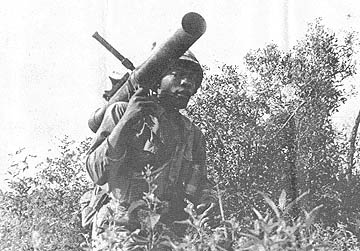 CU CHI - Warriors of the 2d Battalion, 12th Infantry, killed 24
North Vietnamese soldiers ten miles northwest of here in a fierce four-hour
firefight. The 2d Brigade infantrymen sustained no casualties themselves.
CU CHI - Warriors of the 2d Battalion, 12th Infantry, killed 24
North Vietnamese soldiers ten miles northwest of here in a fierce four-hour
firefight. The 2d Brigade infantrymen sustained no casualties themselves.
As the soldiers hit their landing zone and scrambled for cover,
gunships from the 116th Assault Helicopter Company blasted enemy positions from
the sky, killing nine NVA who were fleeing the area.
CHARLIE AND Delta companies then pushed into the area the enemy had
abandoned. At first there was no resistance.
“I had just checked out a freshly dug fighting position when -
blam! A slug hit my rifle butt and sent me sprawling,” related Private First
Class John Harrington of West Springfield, Mass. “He was no more than
five feet away in a hedgerow. My weapon saved my life by stopping his
bullet. I returned fire and then used grenades.”
AFTER THE MASSIVE fire support had ceased, the infantry assaulted
the enemy stronghold. Small arms fire and grenades finished the job.
“I can’t give enough praise for the excellent performance of
our men,” said Lieutenant Colonel John E. Mann, battalion commander. “Our supporting
fire was excellent. Everything went very well.”
Seven AK-47 assault rifles were destroyed; one was captured.
Also confiscated was a 60mm mortar tube complete with baseplate and six rounds.
A LOAD OF TROUBLE (Above) for the enemy waits on the shoulder of
Specialist 4 Percy Miller of Williston, Fla. The Warriors provided more than
enough trouble for NVA in a recent firefight. (PHOTO BY SP4 ART BROWN)
Holy Mackerel What a Fish Story Golden Dragons Tell
By PFC Frank Ditto
CU CHI - A Kit Carson Scout working with soldiers from the 25th
Infantry Division uncovered something fishy in a thickly wooded area just north
of Cu Chi base camp recently.
While searching for signs of the enemy on a three-day mission, Phan
Van Chung, a former Viet Cong and now a scout for men of Bravo Company, 2d
Battalion, 14th Infantry, uncovered a well-camouflaged trap door which led into
a tunnel four feet underground.
Knowing that Viet Cong were in the area, Chung eased himself into
the tunnel and disappeared into an ocean of darkness. The “Bravo
Bandits” waited anxiously for their Kit Carson Scout to call out.
Suddenly, Chung popped his head out of the tunnel and began passing
out cans of one of Charlie’s favorite foods - mackerel. Chung kept
passing out more and more cans of the fish and the men outside began wondering
just how much there was.
Specialist 4 Richard Gregg of Salem, Ohio, and Private First Class
Daniel Zaldivar of Los Angeles, Calif., relieved Chung in pulling out the fish.
Not for three hours did the Bravo Bandits finally succeed in
emptying the tunnel. Final count came to 1,800 cans of mackerel.
“I didn’t think that I’d have any fish stories to tell about
Vietnam,” said Gregg. “But now I guess I do.”
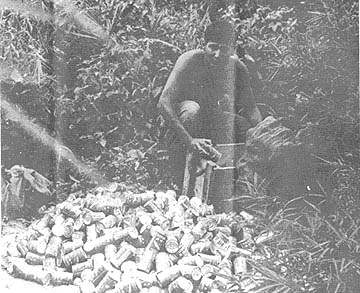 |
PRIVATE FIRST CLASS Dan Zaldivar of Los Angeles inspects the mackerel cache found north of Cu Chi by the men of Bravo Company, 2d Battalion, 14th Infantry. (PHOTO BY SP4 FRANKIE DITTO) |
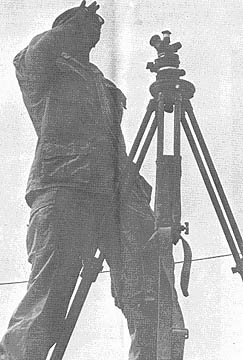 |
Specialist 4 Roger L. Evans of Ashtabula,Ohio, shouts instructions as he sights in preparation for a fire mission for his 4.2-inch mortar. Evans is a member of the 2/34 Armor. (PHOTO BY SP5 DOUG ELLIOTT) |
Thanks to
Mack D. Gooding, 15th PID, 1st Bde., for sharing this issue,
Kirk Ramsey, 2nd Bn., 14th Inf. for creating this page.
This page last modified 8-12-2004
©2004 25th Infantry Division Association. All rights reserved.